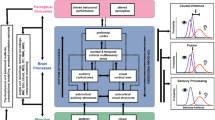Abstract
Understanding the properties and mechanisms that generate different forms of correlation is critical for determining their role in cortical processing. Researches on retina, visual cortex, sensory cortex, and computational model have suggested that fast correlation with high temporal precision appears consistent with common input, and correlation on a slow time scale likely involves feedback. Based on feedback spiking neural network model, we investigate the role of inhibitory feedback in shaping correlations on a time scale of 100 ms. Notably, the relationship between the correlation coefficient and inhibitory feedback strength is non-monotonic. Further, computational simulations show how firing rate and oscillatory activity form the basis of the mechanisms underlying this relationship. When the mean firing rate holds unvaried, the correlation coefficient increases monotonically with inhibitory feedback, but the correlation coefficient keeps decreasing when the network has no oscillatory activity. Our findings reveal that two opposing effects of the inhibitory feedback on the firing activity of the network contribute to the non-monotonic relationship between the correlation coefficient and the strength of the inhibitory feedback. The inhibitory feedback affects the correlated firing activity by modulating the intensity and regularity of the spike trains. Finally, the non-monotonic relationship is replicated with varying transmission delay and different spatial network structure, demonstrating the universality of the results.







Similar content being viewed by others
References
Akerberg OA, Chacron MJ (2010) Coding signal strength by correlated activity in bursting neurons. BMC Neurosci 11(Suppl 1):F3
Bartos M, Vida I, Jonas P (2007) Synaptic mechanisms of synchronized gamma oscillations in inhibitory interneurons networks. Nat Rev Neurosci 8:45–56
Borgers C, Kopell N (2003) Synchronization in networks of excitatory and inhibitory neurons with sparse, random connectivity. Neural Comput 15:509–538
Brunel N, Wang XJ (2003) What determines the frequency of fast network oscillations with irregular neural discharges? I. synaptic dynamics and excitation-inhibition balance. J Neurophysiol 90:415–430
De La Rocha J, Doiron B, Shea-Brown E et al (2007) Correlation between neural spike trains increases with firing rate. Nature 448:802–806
Doiron B, Chacron MJ, Maler L et al (2003) Inhibitory feedback required for network oscillatory responses to communication but not prey stimuli. Nature 421:539–543
Doiron B, Lindner B, Longtin A et al (2004) Oscillatory activity in electrosensory neurons increases with the spatial correlation of the stochastic input stimulus. Phys Rev Lett 93:048101
Kohn A, Smith MA (2005) Stimulus dependence of neuronal correlation in primary visual cortex of the macaque. J Neurosci 25:3661–3673
Li XM, Morita K, Robinson HPC, Small M (2011) Impact of gamma-oscillatory inhibition on the signal transmission of a cortical pyramidal neuron. Cogn Neurodyn 5(3):241–251
Lindner B, Schimansky-Geier L, Longtin A (2002) Maximizing spike train coherence or incoherence in the leaky integrate-and-fire model. Phys Rev E 66(3):031916
Lindner B, Doiron B, Longtin A (2005) Theory of oscillatory firing induced by spatially correlated noise and delayed inhibitory feedback. Phys Rev E 72:061919
Lytton WW, Sejnowski TJ (1991) Simulations of cortical pyramidal neurons synchronized by inhibitory interneurons. J Neurophysiol 66:1059–1079
Maler L (2007) Neural strategies for optimal processing of sensory signals. Prog Brain Res 165:137–156
Marinazzo D, Kappen HJ, Gielen SCAM (2007) Input-driven oscillations in networks with excitatory and inhibitory neurons with dynamic synapses. Neural Comput 19:1739–1765
Mazzoni A, Panzeri S, Logothetis NK, Brunel N (2008) Encoding of naturalistic stimuli by local field potential spectra in networks of excitatory and inhibitory neurons. PLoS Comput Biol 4:e1000239
Middleton WJ, Omar C, Doiron B, Simons D (2012) Neural correlation is stimulus modulated by feedforward inhibitory circuitry. J Neurosci 32(2):506–618
Murphy GJ, Rieke F (2008) Signals and noise in an inhibitory interneuron diverge to control activity in nearby retinal ganglion cells. Nat Neurosci 11:318–326
Ostojic S, Brunel N, Hakim V (2009) How connectivity background activity and synaptic properties shape the cross correlation between spike trains. J Neurophysiol 29:10234–10253
Pakdaman K, Tanabe S, Shimokawa T (2001) Coherence resonance and discharge time reliability in neurons and neuronal models. Neural Netw 14:895–905
Qu JY, Wang RB, Du Y, Cao JT (2012) Synchronization study in ring-like and grid-like neuronal networks. Cogn Neurodyn 6(1):21–31
Smith MA, Kohn A (2008) Spatial and temporal scales of neuronal correlation in primary visual cortex. J Neurosci 28:12591–12603
Tanji K, Suzuki K, Delorme A et al (2005) High frequency gamma-band activity in the basal temporal cortex during picture-naming and lexical-decision tasks. J Neurosci 25:3287–3293
Tchumatchenko T, Geisel T, Volgushev M, Wolf F (2010a) Signatures of synchrony in pairwise count correlations. Front Comput Neurosci 4:1
Tchumatchenko T, Malyshev A, Geisel T (2010b) Correlations and synchrony in threshold neuron models. Phys Rev Lett 104:058102
Tetzlaff T, Rotter S, Stark E, Abeles M et al (2008) Dependence of neuronal correlations on filter characteristics and marginal spike train statistics. Neural Comput 20:2133–2184
Trappenberg T (2008) Tracking population densities using dynamic neural fields with moderately strong inhibition. Cogn Neurodyn 2(3):171–177
Vida I, Bartos M, Jonas P (2006) Shunting ihhibition improves robustness of gamma oscillations in hippocampal interneuron networks by homogenizing firing rates. Neuron 49:107–177
Wang XJ, Buzsaki G (1996) Gamma oscillation by synaptic inhibition in a hippocampal interneuronal network model. J Neurosci 16:6402–6413
Wang WY, Hu L, Valentini E, Xie XB et al (2012) Dynamic characteristics of multisensory facilitation and inhibition. Cogn Neurodyn 6(5):409–419
Acknowledgments
This work is supported by the National Natural Science Foundation of China (No. 61203375, No. 61075105).
Author information
Authors and Affiliations
Corresponding author
Rights and permissions
About this article
Cite this article
Xie, J., Wang, Z. Effect of inhibitory feedback on correlated firing of spiking neural network. Cogn Neurodyn 7, 325–331 (2013). https://doi.org/10.1007/s11571-013-9241-5
Received:
Revised:
Accepted:
Published:
Issue Date:
DOI: https://doi.org/10.1007/s11571-013-9241-5




